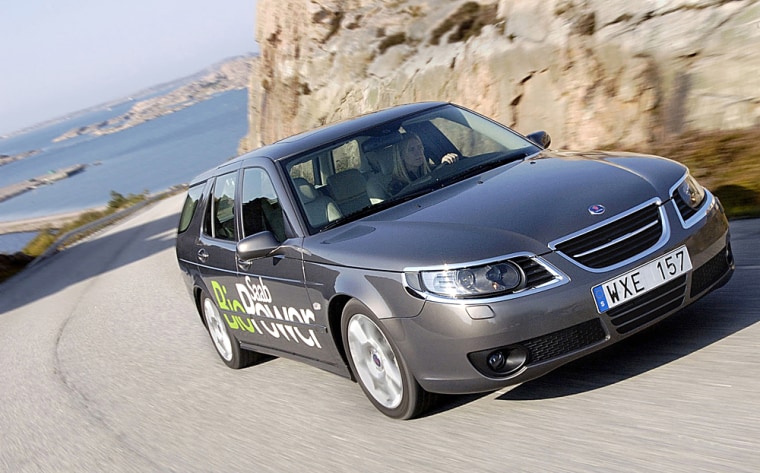A federal push for cars that run on an alternative fuel straight from the heartland isn't winning many converts among American drivers — but is a hit with automakers who use it to skirt mileage standards.
Five million cars across the country are equipped to run on the fuel, but almost no one uses it outside the corn belt.
Fortunately for carmakers, a 1988 law designed to decrease oil use gives them credits for building vehicles that run on the alternative fuel whether anyone uses it or not. Those credits allow automakers to relax gasoline efficiency standards on other vehicles — which drives oil consumption up instead of down.
The situation would be different if many more people replaced the gasoline in their tanks with the fuel known as E85 — a combination of 15 percent gasoline and 85 percent ethanol, a corn-based additive. Flex-fuel cars can run on gas, E85, or combinations of the two.
Ethanol supporters say the extra oil consumption is part of the growing pains of the flex-fuels program, which they say will decrease oil use when more E85 fueling stations are available to drivers.
"You've got to get the cars out before you can get the fueling structure," said Tom Koehler, a spokesman for Pacific Ethanol in Fresno, Calif.
Skewed results
A 2002 Department of Transportation study estimated that E85 accounted for only about 1 percent of the fuel consumed by flex-fuel vehicles between 1996 and 2000 — the equivalent of 26 million gallons.
Relaxed fuel economy standards resulting from flex-fuel credits, meanwhile, were responsible for increased petroleum consumption totaling 772 million gallons — enough gas for a Jeep Grand Cherokee to drive from San Diego to Boston and back more than 1.9 million times.
Often cheaper than gasoline, E85 is known for getting fewer miles to the gallon but higher octane, resulting in more horsepower.

The fuel works in more than 30 models, including General Motor's Yukon, Chevrolet's Silverado, and Ford's Taurus, but many people don't know it. Ford and GM have only recently begun national ad campaigns to promote their vehicles' flex-fuel capabilities, trying to lure consumers skittish over gas prices.
Drivers can see if their vehicle will run on E85 by checking the owner's manual or a Web site, e85fuel.com, that lists compatible models. Ethanol promoters say motorists are often stunned to learn their cars will run on the fuel, but even those well-schooled in E85 may need to drive hundreds of miles to buy it.
At the Los Angeles Auto Show in early January, General Motors announced a partnership with Chevron, California officials and Pacific Ethanol to gauge the public's interest in E85. Those involved said high interest could lead to more pumps nationwide.
Tie credits to use?
The GM initiative is only a small step toward the kind of widespread E85 use that the flex-fuel credit program requires, said Roland Hwang, a senior policy analyst for the National Resources Defense Council.
"If this is the beginning and the end, this is less than a drop of the bucket," said Hwang. He said the incentive program should end if it continues to promote rather than discourage oil use.
Therese Langer, transportation program director for the American Council for an Energy-Efficient Economy, said the program should allow automakers to reduce fuel efficiency standards only if drivers actually use E85 in their vehicles. That use could be monitored by tracking E85 sales.
With strong support from automakers, the incentives program was renewed in the sweeping energy bill President Bush signed last August.
Ethanol's promoters call it a clean-burning fuel that helps farmers in the nation's corn belt while reducing greenhouse emissions and shifting the nation's dependence on foreign oil.
"It's 100 percent domestic," said Phillip Lampert, executive director of the National Ethanol Vehicle Coalition. "We don't have to fight wars to bring it in."
Energy efficiency debated
Critics see the ethanol program as a waste of $3 billion a year in state and federal subsidies, pointing to a study last year by professors at Cornell University and the University of California, Berkeley that said ethanol takes more energy to make than it produces. Ethanol producers dispute the finding.
GM said it would try to promote the fuel by offering 50 to 100 of its flex-fuel vehicles to California in the state's annual competitive bidding process. Chevron will work with the state to provide E85 fueling pumps, with Pacific Ethanol providing the E85.
The 2002 federal study offered several scenarios for the flex-fuel program's future effect on petroleum consumption. If the percentage of E85 used in flex-fuel vehicles remains at 1 percent from 2001 to 2008, the amount of petroleum consumed could increase by more than 17 billion gallons.
The study projected that if every E85-compatible vehicle ran solely on the fuel in 2006, more than 2.1 billion gallons of oil would be saved this year.
Shortage of stations
That scenario, however, is impossible.
Though flex-fuel vehicles are sold nationwide, only 30 states have public E85 fueling stations. Most are in the corn belt, and some states have only a handful. California, the nation's largest auto market, has only one in San Diego.
Tim Gerlach, a spokesman for the American Lung Association of the Upper Midwest, where E85 is most popular, said the program's success will depend on the public demanding more cars and fueling stations as they wait for longer-term fixes to the nation's oil dependency.
"You need more vehicles, better availability of the fuel, and more awareness," said Gerlach, who owns a flex-fuel Ford Taurus. "Here is something we can do very easily now."
